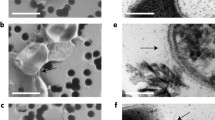Summary
Formate transport and the effect of formate on growth and the membrane protonmotive force were studied in two ribulose-monophosphate-type obligate methylotrophs (bacterial strains T15 and L3). Formate was accumulated very fast by the membrane ΔpH according to the general transport mechanism of short-chain organic acids. Formate accumulation was reduced or abolished by a number of factors (protonophores, high extracellular pH, cell-starvation conditions) that reduced or abolished the ΔpH. Formate transport was accompanied by removal of protons from the medium by the cells. Since protons are released by the cells upon substrate oxidation, the stoichiometry of proton uptake upon formate transport could not be directly determined, although data suggest that formate is cotransported with one proton. The net rate of proton removal from the medium by the cells due to formate transport and oxidation increased with increasing formate concentrations or decreasing medium-pH values. The membrane protonmotive force of strain T15 was also studied as a function of the pH. High formate concentrations (of 100 to 400 mM) reduced the membrane ΔpH by ca. 20 to 60% and the growth rate by ca. 20 to 100% for both strains but to a different extent. For example, 400 mM formate inhibited growth by ca. 60% in strain T15 and by 100% in strain L3. The nature of growth inhibition by formate is discussed in some detail.
Similar content being viewed by others
References
Anthony C (1982) The Biochemistry of Methylotrophs. Academic Press, London
Babel W, Muller RH, Markuske KD (1983) Improvement of growth yield of yeast on glucose to the maximum by adding an additional energy source. Arch Microbiol 136:203–208
Baronofsky JJ, Schreurs WJA, Kashket ER (1984) Uncoupling by acetic acid limits growth of and acetogenesis by Clostridium thermoaceticum. Appl Environ Microbiol 48:1134–1139
Ben-Bassat A, Goldberg I, Mateles RI (1980) Distribution of methanol carbon between assimilation and oxidation pathways in methanol-grown Pseudomonas C. J Gen Microbiol 116:213–223
Booth IR (1985) Regulation of cytoplasmic pH in bacteria. Microbiol Rev 49:359–378
Bussineau CM, Keuer TA, Chu I-M, Papoutsakis ET (1987) Effect of growth conditions on enzyme activities, intracellular kinetics and biomass yields of a new RuMP-type methylotroph (T15). Appl Microbiol Biotechnol 26:61–69
Chu I, Bussineau CM, Papoutsakis ET (1985) Direct measurement of carbon-substrate oxidation and incorporation patterns in RuMP-type methylotrophs: chemostatic cultures of Methylomonas L3. Biotechnol Bioeng 27:1623–1633
Chu I, Papoutsakis ET (1987) Growth dynamics of a methylotroph (Methylomonas L3) in continuous cultures. I. Fast transients induced by methanol pulses, and methanol accumulation. Biotechnol Bioeng (in press)
Cobley JG, Cox JC (1983) Energy conservation in acidophilic bacteria. Microbiol Rev 47:579–595
Dawson MJ, Jones CW (1982) The protonmotive force and phosphorylation potential developed by whole cells of the methylotrophic bacterium Methylophilus methylotrophus. Arch Microbiol 133:55–61
Dijkhuizen L, Wiersma M, Harden W (1977) Energy production and growth of Pseudomonas oxalaticus OX1 on oxalate and formate. Arch Microbiol 115:229–236
Diwan AR (1985) Transport of methanol and formaldehyde in Methylomonas L3 and methylotrophic strain T15. PhD thesis, Rice University, Houston, TX, USA
Diwan AR, Chu I, Papoutsakis ET (1983) Substrate transport and its effect on the dynamics of methylotrophic growth. Biotechnol Lett 5:579–584
Egli T, Harder W (1984) Growth of methylotrophs on mixed substrates. In: Crawford RL, Hanson RS (eds) Microbial Growth on C1 Compounds, American Society for Microbiology. Washington, DC, USA, pp 330–337
Haggstrom MH, Dostalek M (1981) Growth of Methylomonas methanolica: factors influencing growth yield. Eur J Appl Microbiol Biotechnol 12:107–112
Hammond RC, Rees B, Higgins IJ (1981) Factors affecting proton translocation by facultative methylotrophs. Biochim Biophys Acta 638:22–29
Herrero AA, Gomez RF, Snedecor B, Tolman CJ, Roberts MF (1985) Growth inhibition of Clostridium thermocellum by carboxylic acids: a mechanism based on uncoupling by weak acids. Appl Microbiol Biotechnol 22:53–62
Hirt W, Papoutsakis ET, Krug E, Lim HC, Tsao GT (1978) Formaldehyde incorporation by a new methylotroph (L3). Appl Environ Microbiol 36:55–62
Huesemann M, Papoutsakis ET (1986) Effect of acetoacetate, butyrate, and uncoupling ionophores on growth and product formation of Clostridium acetobutylicum. Biotechnol Lett 8:37–42
Keuer TA (1984) Isolation, characterization and substrate-transport studies of a new, unique methylotroph. MS thesis, Rice University, Houston, TX, USA
Papoutsakis ET, Bussineau CM, Chu I-M, Diwan AR, Huesemann M (1987) Transport of substrates and metabolites and their effect on cell metabolism [in butyric-acid and methylotrophic fermentations]. Ann NY Acad Sci (in press)
Papoutsakis E, Lim HC, Tsao GT (1978) Role of formaldehyde in the utilization of C1 compounds via the ribulose monophosphate cycle. Biotechnol Bioeng 20:421–442
Papoutsakis E, Lim HC (1981) Single cell protein production on C1 compounds. The bioefficiency. Ind Eng Chem Fundam 20:307–314
Papoutsakis E, Hirt W, Lim HC (1981) Bacterial utilization of pure and mixed C1 compounds for single cell protein production. Biotechnol Bioeng 23:235–242
Puhar E, Lorencez I, Guerra LH, Fiechter A (1982) Limit to cell mass production in continuous culture of Methylomonas clara. J Ferment Technol 60:321–326
Rodionov YuV, Zakharova EV (1980) Two pathways of formate oxidation in methylotrophic bacteria. Biokhimiya 45:854–862
Seidell A (1940) Solubilities of inorganic and metal organic compounds, vol 1, 3rd ed, Van Nostrand, New York, p 1354
Swartz JR, Cooney CC (1981) Methanol inhibition in continuous culture of Hansenula polymorpha. Appl Environ Microbiol 41:1206–1213
van Verseveld HW, Stouthamer AH (1978) Growth yield and the efficiency of oxidative phosphorylation during autotrophic growth of Paracoccus denitrificans on methanol and formate. Arch Microbiol 118:21–26
Waddell WJ, Butler TC (1959) Calculation of intracellular pH from the distribution of 5,5-dimethyl-2,4-oxazolidinedione (DMO). J Clin Invest 38:720–729
West IC, Mitchell P (1973) Stoichiometry of lactose-H+ symport across the plasma membrane of Escherichia coli. Biochem J 132:587–579
Author information
Authors and Affiliations
Rights and permissions
About this article
Cite this article
Chu, IM., Keuer, T.A. & Papoutsakis, E.T. Formate transport, growth inhibition and the membrane protonmotive force in two methylotrophs (T15 and L3). Appl Microbiol Biotechnol 26, 70–77 (1987). https://doi.org/10.1007/BF00282151
Received:
Revised:
Issue Date:
DOI: https://doi.org/10.1007/BF00282151




